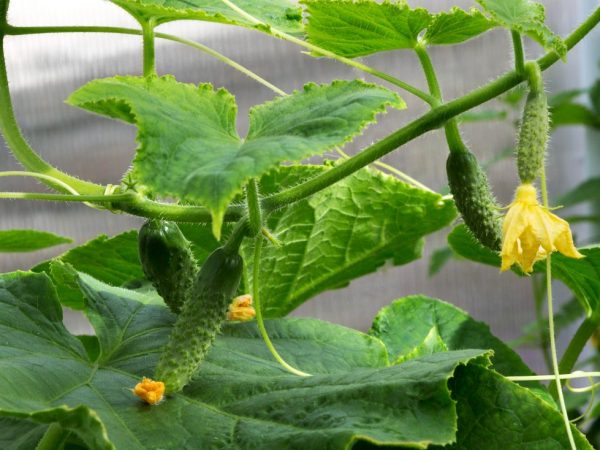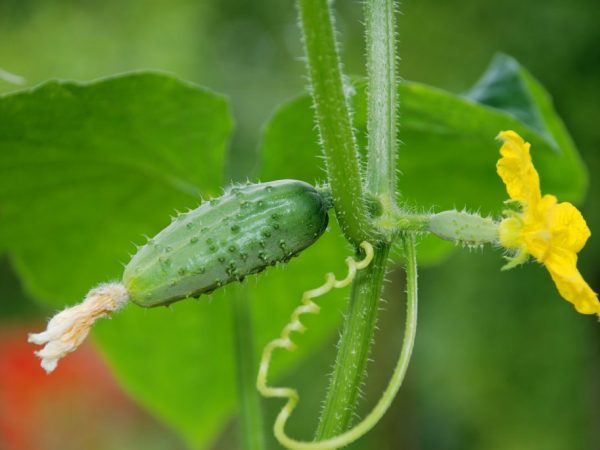Description of the variety of cucumbers Parisian gherkin
Cucumber variety Parisian gherkin is a favorite vegetable for many farmers. Lovers of small crunchy cucumbers will appreciate the culture for its excellent taste and noble appearance.

Description of the variety of cucumbers Parisian gherkin
Characteristics of culture
The characteristic of the variety is not distinguished by any innovations. The Parisian f1 cucumber variety was bred by Russian farmers by crossing several types of gherkins. Early ripening vegetable crops are grown both in the open field and in greenhouse conditions.
Planting is done in mid-April or early May. Harvesting takes place 40-45 days after sowing. Pollination occurs with the help of insects.
Description of the plant
Cucumber bushes have many branches and can intertwine with each other. The average growth of the lashes is up to one and a half meters in height.
The leaves are large, dark green in color. The flowers are bright yellow or beige and have a bell-shaped appearance.
Description of the fetus
Experienced gardeners describe vegetables, saying that they are amazing in taste and have a very attractive appearance:
- the weight of the cucumbers is about 50g;
- length from 5cm to 7cm;
- the peel has a green tint, there is black pubescence on the cucumber tubercles;
- the pulp is light green, tender and sweetish in taste;
- the seeds are not large;
- when cutting, voids are not formed.
Advantages and disadvantages
The main advantages of a hybrid variety of cucumbers is a high yield, from 1 m2 - 15-18 kg. The variety is suitable both for raw consumption and for pickles and pickles. Due to its appetizing appearance, it looks great in cans.
After removal from the garden, it has an excellent shelf life of up to several weeks, while it does not change its properties. This variety is grown not only for personal consumption, but also on an industrial scale.
Among the shortcomings, one can single out susceptibility to certain diseases, such as Powdery Mildew.
Growing methods
Growing vegetables does not require any special skills. The main thing is to decide on the landing method:
- germination of seedlings;
- planting seeds in the ground.
Cucumber The Parisian gherkin is often grown using seedlings because this method allows farmers to harvest faster.
Seed preparation

With the help of seedlings, the harvest can be obtained earlier
Before you start planting seeds in open ground or just plant them like seedlings, you need to pre-select and disinfect the seed. So, to carry out the selection of planting material, follow the following recommendations for the selection of seeds, they should be:
- large;
- even;
- without defects;
- not empty.
Choose only the best seeds for planting, otherwise you risk being left without a crop. Indeed, from the wrong choice of material for planting, the plant can get sick or not germinate at all.
To make sure that the seeds are suitable for growing, they must be tested for germination in a solution of sodium chloride: 1 5 tbsp. spoons per liter of water. After preparing the solution, immerse the seeds there for 10 minutes; after a while, the floating specimens should be thrown away. It is important to remember that this sampling method is carried out only on fresh seeds: 1-2 year old seeds will float, even those that are suitable for sowing.
After selection, we proceed to disinfect future seedlings, for this you need a 1% potassium permanganate solution, into which we introduce the selected seeds and leave for half an hour.
How to grow seedlings
To start growing seedlings you will need:
- seeds;
- several boxes.
Before germination, seeds should be prepared by treating them in a disinfecting solution. After carrying out all the necessary procedures, you can start planting in the boxes. To do this, you need to moisten and loosen the soil, which is in containers. Then poke the seeds for seedlings into the soil, keeping a distance of 4-5 cm between them. Water the seedlings as needed. When the sprouts release 2-3 leaves, this means that the plant is ready for planting.
Landing in the ground
Planting in the soil should be carried out when the air temperature outside has already been established and the thermometer shows 15. First, you should take care of hardening the sprouts so as not to lose the seedlings from a sharp temperature drop. To do this, it will take several days to take out the seedlings outside, each time gradually increasing the time spent outdoors.
We dig holes at a distance of 40-50 cm from each other so that 4-5 plants come out per 1 m2. Then, in the course of growth and development, the lashes will not interfere with each other. Sand drainage can be made at the bottom of the hole.
Plant care
The planting site should be well lit, because the Parisian gherkin cucumber requires a lot of sun. Water should be abundant, especially during periods of rapid growth.
If required, tall lashes can be tied up. It is advisable to pick ripe vegetables every day, then they will not outgrow and slow down the development of the next fruits. Moreover, gherkins should be small, then they are best suited for pickling.
Diseases
Cucumber Parisian gherkin, like other vegetables, is susceptible to disease and pest attacks. The most common disease affecting cucumbers is powdery mildew. It appears in the form of white spots on leaves and stems, and later affects the entire plant as a whole. As a result of the disease, whole lashes of the plant begin to die off, which leads to a decrease in yield.
High humidity leads to the disease. In the fight against powdery mildew, ground sulfur is used, as well as mechanical processing of the plant: breaking off damaged leaves and stems.
Also, cucumbers are affected by Downy mildew or Peronosporosis. With a disease, the leaves are covered with yellow spots with a bloom. The disease spreads quickly and can wipe out half of your fees. If Peronosporosis has already attacked your seedlings, then a solution of iodine or urea is used in the fight against it. In preventive measures, so that the disease does not attack your plants, it is necessary to select a variety that is resistant to this kind of infection in advance. Pre-disinfection of seeds before planting will also help.
Root rot affects the rhizome of the vegetable crop and causes the lash to dry out. The infection is very persistent, therefore it remains in the soil for a long time. In the fight against rot, they use: warm watering, sprinkle with sawdust or sand under the bush. The description of the variety confirms that it is suitable for every interested gardener.


